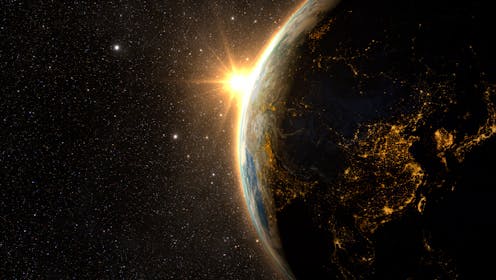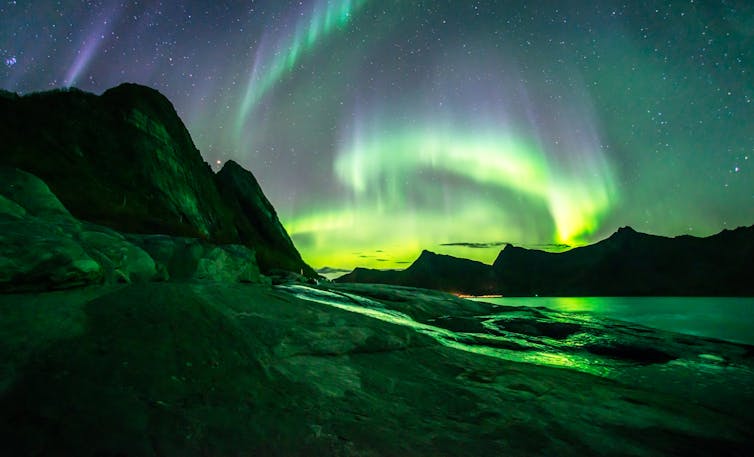
Could the Earth stop spinning, and if it did, what would happen? – Paul, aged 12, Aberdeen, Scotland
The Earth has been spinning since its birth, four and a half billion years ago.
The Earth was made from rubble that was left over when the Sun formed from the collapse of a huge cloud of matter. The rubble that went on to become the Earth circled around the Sun like water does around the plughole when you empty a bathtub, spinning as it went.
The Earth continued to circle the Sun and spin after it was formed and is going to spin like this for a long while to come.
The Earth spins steadily, once every 23 hours and 56 minutes. During this time, the Earth also moves a little further on its orbit around the Sun, which takes one year to complete. This means it needs to turn a bit more – for four minutes – until it faces the Sun again. This means that one day on Earth lasts 24 hours.
Moving in space
The reason the Earth keeps spinning is because there is hardly anything to stop it. If you spin a roundabout in a playground and let go, eventually it will come to a stop. This is because as it spins, the air and the surface of the playground are pushing against it, causing friction and slowing it down.
The Earth is spinning in space, which is pretty much empty. In space, there is not even air to push against and slow down the Earth’s spin.

Curious Kids is a series by The Conversation that gives children the chance to have their questions about the world answered by experts. If you have a question you’d like an expert to answer, send it to curiouskids@theconversation.com and make sure you include the asker’s first name, age and town or city. We won’t be able to answer every question, but we’ll do our very best.
However, there is one thing that slows down the Earth’s spin: the Moon.
The motion of the side of the Earth facing the Moon is not balanced perfectly by gravity, and neither is the side of Earth facing away from the Moon. This imbalance creates the ocean tides, which make the oceans bulge out on either side of the Earth.

Ivan Sorokin/Shutterstock
As the Earth spins, these bulges move across the Earth’s surface like a wave, pushing against the Earth’s spin. This slows down the Earth’s spin. It means that Earth’s day lengthens by one second every 50,000 years.
The only thing that could stop the Earth’s spin would be if another planet crashed into it. Even if this happened, it is more likely that it would change the way Earth spins, not stop it altogether.
A six-month day
If the Earth stopped spinning, you wouldn’t suddenly be launched off into space. Gravity would still keep you firmly on the ground.
There would be lots of changes, though. If Earth were to stop spinning but continue to orbit the Sun, a “day” would last half a year, and so would the night. It could warm up much more during the day and cool down much more during the night. This would affect the climate on Earth.
A large temperature difference between day and night would cause strong winds, which would move warm air towards the cooler, nighttime side of the Earth. Wind would also blow from the warm regions around the equator to the cold polar regions. On a spinning Earth, this does not happen because the wind is deflected sideways.
The eastwards and westwards winds, and the winds towards the poles, would meet. They could possibly create huge swirls of wind the size of entire continents.
The core of the Earth is partly molten iron. The spinning motion of the Earth turns this molten iron into a magnet and gives the Earth a magnetic field.
This protects us against harmful radiation, which comes from particles from the Sun and cosmic rays from outside the solar system. While the magnetic field stops the radiation from reaching us, it hits the Earth’s atmosphere, and we see it as the aurora – the northern or southern lights.

Auroras Perfection/Shutterstock
Without the magnetic field, this radiation would reach the Earth’s surface and make people ill. Some birds use the magnetic field to find their way, so without the Earth spinning, they would get lost.
If the Earth didn’t spin, the night sky would always show the same constellations of stars, because you would always be looking out into space in the same direction. This is very different from seeing the stars rise and set during the night, and seeing different constellations at different times of the year.
![]()
Jacco van Loon does not work for, consult, own shares in or receive funding from any company or organisation that would benefit from this article, and has disclosed no relevant affiliations beyond their academic appointment.
Source: TheConversation



